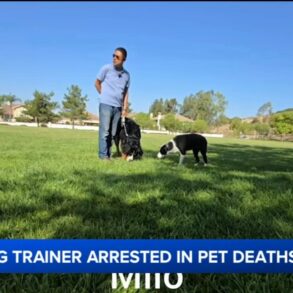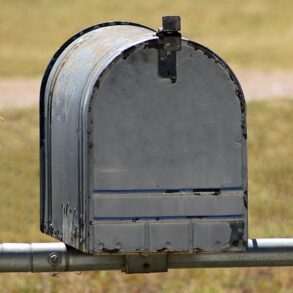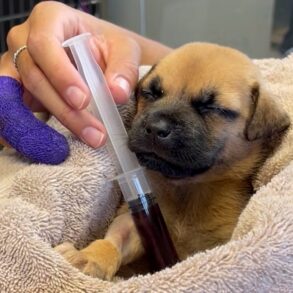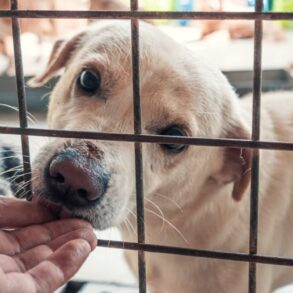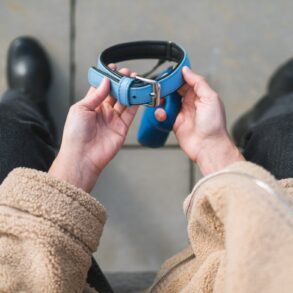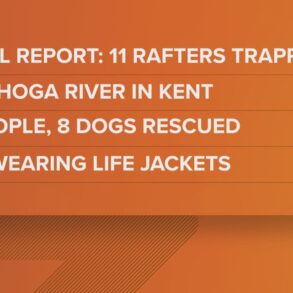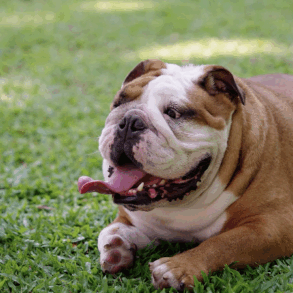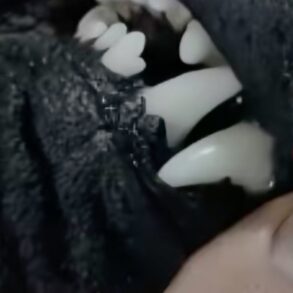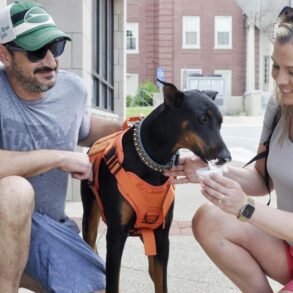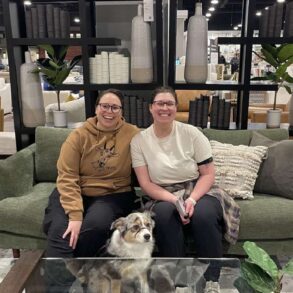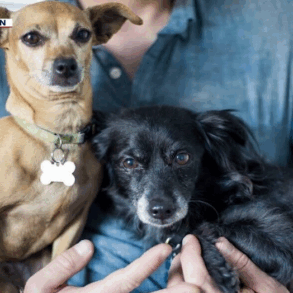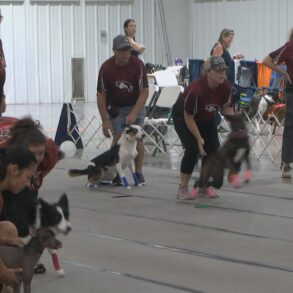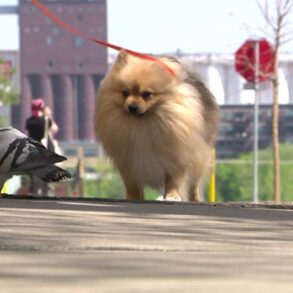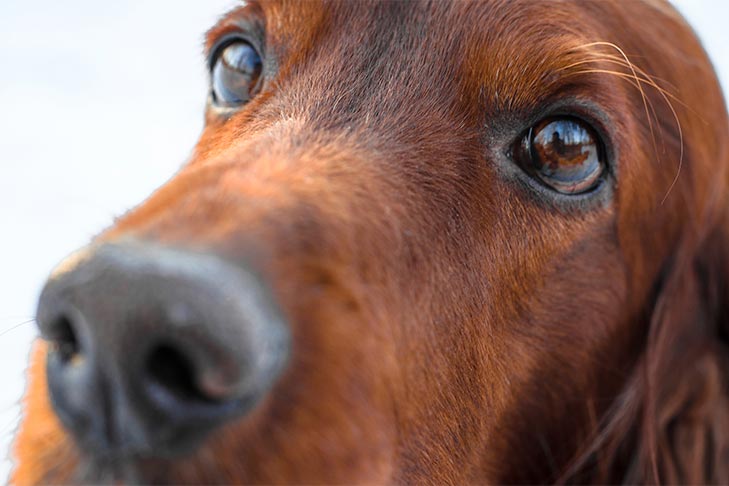
Healthy eyes in a dog look clear, bright, and free of redness or discharge. To help keep them that way, you might be wondering if your dog needs eye protection. Protective eyewear can help with managing certain health conditions like cataracts. Since not all dogs will tolerate goggles and might even pull them off and chew on them, it’s important to be informed before purchasing eye protection.
Read on for advice from veterinarians about the different types of eye protection for dogs, when dogs need to use them, and how to ensure they fit properly.
Types of Eye Protection for Dogs
Eye protection shields a dog’s eyes in “situations where they might be exposed to ultraviolet (UV) rays, dirt, debris, or other environmental hazards,” says Bethany Hsia, DVM, veterinarian at CodaPet. Examples are outdoor activities, water sports, or being in dusty environments. If you’re unsure whether your dog needs eye protection, it’s a good idea to consult with your veterinarian.
The most common type of eye protection for dogs is goggles which can be clear or tinted. Another option is a sun visor or hat.
Goggles
“If your dog spends a lot of time outdoors in sunny conditions, goggles or sunglasses can help protect their eyes from UV radiation, strong winds, dirt, and debris,” Dr. Hsia says. They’re beneficial for dogs riding on a bicycle or motorcycle, hanging their head out of the car window, or running or jogging with their owner. Another reason to use goggles is during foxtail season when these seeds can become embedded in their eyes or skin, says Sara Adelman, DVM, MS, Associate Veterinarian at Vet Vision Center.
Goggles come in a variety of designs and colors and are relatively inexpensive. For dogs who swim regularly or participate in dock diving, goggles can prevent water from splashing in their eyes, limit the glare coming off the water, and reduce chlorine or saltwater irritation, Dr. Hsia says. In addition, goggles can be helpful for dogs prone to eye injuries including those who are blind, spend much of the day outside, or work in harsh conditions such as K-9s in law enforcement, the military, or search and rescue, Dr. Adelman says.
Visors and Hats
Another option for outdoor sun protection is dog visors and hats. Visors have a round brim like a baseball cap while hats fit over a dog’s head with cutouts for their ears. Visors and hats provide shade from direct sunlight, but they won’t prevent debris from entering a dog’s eyes.
While visors can offer some sun protection, they don’t provide UV protection, says Marnie Ford, BSC, PhD, DVM, DACVO, a board-certified veterinary ophthalmologist. “Sometimes a visor helps keep the glare out of their eyes, so it’s not so overwhelmingly bright for them.” Another use for visors is for an eye condition that requires blocking light and your dog won’t tolerate goggles, she adds.
When to Use Eye Protection
Any dog breed can develop conditions like glaucoma, cataracts, and uveitis. If your dog spends a lot of time on the water or ski slopes, there’s an increased risk of damage from UV light because they have greater exposure over a shorter amount of time, Dr. Ford explains. “So, we aren’t talking about the amount of UV,” she says. “We’re talking about the cumulative effect of UV light.”
There are several reasons to consider using eye protection for your dog including the following.
Allergies and Conjunctivitis
Pink eye or conjunctivitis in dogs is a common condition that occurs when the tissue inside the eyelid or covering the eyeball becomes inflamed. It can be caused by allergies, bacteria, viruses, eyelid abnormalities, and trauma to the eye. “Often, we want to use goggles because they have a little bit of a tighter fit around their face, so they don’t get wind and air moving in which brings in allergens or particulates that bug the dog,” Dr. Ford says.
Glaucoma
Goggles can also be helpful for glaucoma, a disease where there is increased pressure within the eye. “When dogs have glaucoma, they have a really dilated pupil and this increases the amount of light that gets in their eyes, so they can suffer from the glare,” Dr. Ford explains. Along with prompt veterinary care, using tinted goggles or a visor can help if your dog has a sensitivity to light.
Cataracts
When a dog develops a cataract, the lens which is normally clear becomes cloudy or opaque. This can block light from reaching the retina and impair a dog’s vision. “When dogs don’t have complete mature cataracts, the light will go in and scatter, and it’s really irritating and can overwhelm them,” Dr. Ford says. Wearing tinted goggles can reduce the amount of light going in, as well as the glare and scatter.
“Dogs who live in places with a lot of snow can get actinic cataracts,” Dr. Ford says. These cataracts are the result of long-term exposure to UV light. “In fact, human teenagers are getting cataracts from snow glare or UV light exposure which never used to happen, and dogs too will get actinic cataracts,” she says.
Iris Atrophy
“Since older dogs often experience degenerative eye diseases, they can benefit from protection against environmental factors,” Dr. Hsia says. For instance, some dogs can develop iris atrophy which occurs when “the pupillary margin starts to break down,” Dr. Ford says. “This is a normal part of aging, but the consequence is that the pupils don’t close fully which allows more light to enter the eye.” Wearing goggles can reduce the amount of bright glare during the day.
Pannus
Certain breeds like German Shepherds and Greyhounds can develop a condition called Pannus that is linked to UV exposure and high altitudes, Dr. Adelman says. She explains that Pannus is an “immune-mediated process” involving inflammation of the cornea. “Normally, it starts at the outer corners of the cornea and can cause vision loss through long-term changes or generalized inflammation, making the cornea cloudy,” she says. Pannus can cause pain and needs lifelong management. “Having UV protection on these dogs is required, especially when you have dogs who work outside all day,” Dr. Ford says.
Uveitis
Some dogs develop uveitis which means “inflammation of the uveal tract or inflammation inside of the eye,” Dr. Ford says. When a dog has uveitis, one of the problems that happens is the pupil becomes miotic, meaning small and constricted, which is quite painful. If it’s sunny outside, the pupil can become “almost hyper-miotic, so when you have tinted goggles, they’ll reduce the amount of light going in the eye, which reduces pain,” she adds.
Dry Eye
Some dogs don’t produce enough tears resulting in a condition called dry eye. “Having goggles on their eyes that are a bit fitted, but not tight, means less airflow around their eyes,” Dr. Ford says. Less air means the tear film doesn’t dry out as much which is helpful in hot, dry weather.
After Surgery
All three experts recommend an e-collar or cone if your dog is recovering from eye surgery or an injury to the eye. “However, if you need goggles or your dog won’t wear a cone, because some dogs absolutely hate cones, goggles made for dogs are really helpful,” Dr. Ford says. “Postoperatively, a lot of dogs have reduced blinking and reduced tear production, so they’re much more vulnerable to trauma.”
When you have a surgical site, you don’t want them causing further trauma to the eye from rubbing or pulling at their stitches. “Ideally, you’re going to use a cone or a goggle,” Dr. Ford says. You do have to be careful though since your dog could pull off the goggles and cause further damage to their eyes.
What to Look for When Purchasing Protective Eyewear
Lenses
Goggles have individual eye lenses or a single lens that goes over the whole front of the eye. The single-lens goggles “are usually better for wider fields of view,” Dr. Ford says. Lenses can also be clear or tinted and both kinds may come with UV protection. “The tinted lenses are needed in sunny conditions,” she says. But tinted goggles wouldn’t be a good choice on evening walks or doing search and rescue in the dark.
“The clear lenses would be good for dogs who swim underwater,” Dr. Ford says. “It doesn’t keep water out of the goggles because dogs have hair, and you don’t get a tight seal like you do with human goggles.” Although dogs can open their eyes underwater, you wouldn’t want to use a tinted goggle because they won’t be able to see anything.
Materials
Ensure the product you purchase offers 100% UV protection, Dr. Hsia says. She also recommends avoiding materials that irritate your dog’s skin or eyes. Choose goggles made of lightweight yet durable materials such as polycarbonate lenses.
Safety
If your dog is wearing goggles for an extended period, make sure to monitor them. “I wouldn’t leave them overnight with goggles,” Dr. Ford says. “Any dog that you’re going to be leaving for a length of time with goggles on, I would be more inclined to put an e-collar on them, so it’s safer and just in case they did move them around and get them in the wrong location.”
Dr. Adelman agrees, saying “a hard plastic e-collar that goes out in front of the nose is the only protection I use after any surgery or a deep corneal ulcer.” Another option is an Optivizor which goes over the head and eyes and can be clear or tinted depending on how much UV protection your dog needs. This may be a good choice if your dog is very anxious about the e-collar or tries to get it off immediately, she adds.
Size and Fit
“Choosing the correct size for your dog’s eye protection is crucial for comfort and effectiveness,” Dr. Hsia says. If the eyewear is too loose, it can allow debris to enter the eye and cause irritation. But if it’s too tight, it can be uncomfortable for your dog, she says. Companies that make goggles often have sizing charts on their website to help you choose the right size for your dog.
Goggles have adjustable straps that go behind the head and below the chin, so you can customize the fit. When fitting goggles on your dog, “make sure there’s no point at which the goggle is touching the eye, which is why the ski goggles are great because they’re pretty wide around the eye,” Dr. Adelman says.
Dog visors and hats usually have a Velcro, hook and loop closure, or buckle, so you can adjust the size. Look for a hat with a drawstring that goes under the chin to keep it securely on your dog’s head.
Made for Dogs
You might be wondering if you can use baby goggles for your dog. The simple answer is no. “Using human eye protection is generally not recommended due to fit issues,” Dr. Hsia says. Dr. Ford agrees saying that the ones used for children aren’t fitted for dogs and don’t have the adjustable strap that goes below a dog’s chin.
How to Get Your Dog Accustomed to Eye Protection
Introducing your dog to protective eyewear is a gradual process. You want them to associate wearing goggles with positive experiences like getting a treat or playing. “Start by letting your dog sniff and explore the goggles without putting them on,” Dr. Hsia says. “This helps reduce anxiety about new objects.”
Once your dog seems comfortable, she suggests placing the goggles on them briefly while rewarding them with treats and praise. Patience is key to encouraging acceptance. “If your dog shows signs of distress, remove the eye protection immediately and try again later,” she says. “Some dogs adapt quickly while others take longer.”
Keep in mind that eyewear shouldn’t interfere with a dog’s ability to do regular activities like walking or drinking, Dr. Adelman says. Dr. Ford agrees, adding that “while eye protection is a good idea in many situations, I wouldn’t force goggles on them because the dog will try to get them off and can displace them, and that can cause more damage.” If your dog doesn’t tolerate goggles, she recommends taking precautions like using a visor, walking your dog on the shady side of the street, keeping them out of the sun from 10 am to 2 pm when UV radiation levels are highest, and providing more shade in the backyard.
This post was originally published on this site be sure to check out more of their content.






